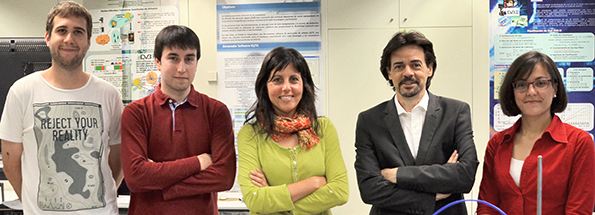Phantoms
The UPV develops new synthetic models for creating technology medical examination and testing of devices 5G
[ 13/07/2016 ]
Researchers at the Universitat Politècnica de València (UPV) have developed new synthetic models (phantoms) that simulate the electromagnetic properties of several human tissues and organs, such as complex relative permittivity, dielectric constant, loss factor and conductivity. These models may be of interest for developing new technologies for medical screening, and in general, for testing 5G mobile communication devices. The researchers also devised the methodology to create the phantoms.
Recently, there has been a growing interest in the use of new telecommunication devices that facilitate clinical diagnosis when implanted in the organism. These units can be integrated inside capsules and taken orally. This is the case for sensors and medical monitoring systems that register biological information inside the body and later transmit it outside.
Electromagnetic waves through the body
According to UPV researchers, these devices wirelessly communicate sending electromagnetic waves through the body, which acts as a transmission medium. In order to develop and test them before they are marketed, it is necessary to perform tests on animals and humans.
In fact, the models and methodology developed by the researchers and patented by the Universitat Politècnica de València will reduce testing on animals and humans. They will help to assess the transmission of electromagnetic waves in UWB (ultra-wide band) frequency, which is between 3.1 and 10.6 GHz; and will take part on future personal area networks, as well as other networks of narrower bands, such as ISM networks.
The phantom is a liquid mixture or a crosslinked polymer (hydrogel) that can be formed according to the shape and size of interest, in order to simulate a specific organ at an electromagnetic level that is able to hold those liquids or mixtures.
Simulating "on demand"
With the new methodology developed by the researchers, organs such as the liver, heart, pancreas, colon and cartilage can be simulated “on demand” from an electromagnetic point of view. For some of them, there are no phantoms on the market today, nor proposals for any in the future, not even for a specific frequency.
Noticias destacadas
 Acabar con la pobreza infantil en España aumentaría el PIB un 5'7%
Acabar con la pobreza infantil en España aumentaría el PIB un 5'7%
La pobreza infantil en España, a debate en unas jornadas organizadas por la Cátedra de Infancia y Adolescencia de la UPV, en Torrevieja
 QS rankings por materias
QS rankings por materias
La UPV, reconocida como mejor universidad de España para estudiar tanto Ingeniería Agroalimentaria y Forestal como Arte y Diseño
 La 'Escuela de Diseño' cambia de nombre
La 'Escuela de Diseño' cambia de nombre
La ETSIADI (Escuela Técnica Superior de Ingeniería Aeroespacial y Diseño Industrial) sustituye la denominación de ETSID
 La UPV, en la semifinal de Solo de Ciencia
La UPV, en la semifinal de Solo de Ciencia
Entre los diez semifinalistas, se encuentran Miguel López, investigador del CVBLab-Human Tech y Carolina Ropero, doctoranda en la UPV
 Primeros pasos del museo Ciència fallera de la UPV
Primeros pasos del museo Ciència fallera de la UPV
La UPV celebra el acto de entrega de premios del I concurso "La Ciència a les Falles". Los ninots ganadores, los primeros de este nuevo museo de la universidad
 UPV-CLÍNIC
UPV-CLÍNIC
La UPV e INCLIVA firman un convenio para impulsar conjuntamente la innovación en el ámbito de la salud







